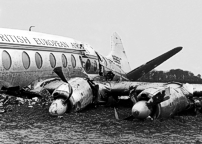
May 1957 to November 1957
British European Airways Corporation (BEA)
G-AOHP - c/n 165 - a V.802 series Viscount
United Kingdom registered
February 1953
An order was placed for the first 800 series Viscount which was specifically designed for British European Airways Corporation (BEA).
This was the 16th Type 802 ordered by British European Airways Corporation (BEA).
Production Aircraft No. 16 - the 16th production 800 series Viscount built,
was the 16th 800 series Viscount fuselage assembled at Hurn, Bournemouth, Hampshire, England,
and the 16th 800 series Viscount assembled at Weybridge, Surrey, England.
Production Order No. F16/802. Sales Order No. F16/63B. Stock Order No. F16/26B.
10 November 1956
Fuselage assembly commenced at Hurn Airport, Bournemouth, Hampshire, England.
December 1956 - January 1957
Fuselage transported by road from Hurn Airport, Bournemouth, Hampshire, England to Weybridge, Surrey, England.
8 January 1957
Fuselage to Erecting Shop 'E' at Weybridge, Surrey, England.
4 May 1957
First flight from Brooklands Airfield, Weybridge, Surrey, England.
It landed at Wisley Airfield, Surrey, England for fitting out and test flying.
17 May 1957
Delivered to British European Airways (BEA) named as 'R M A James Weddel'.
21 May 1957
Noted at Blackbushe Airport, Hampshire, England due to a London Airport weather diversion.

Forced landed in a field near Ballerup, Denmark
17 November 1957
Damaged beyond repair after a forced landing in a field near Ballerup, Denmark while on a cargo flight to Kastrup Airport, Copenhagen, Denmark carrying mail, freight and newspapers from London Airport (Heathrow), Middlesex, England.
Total time 989 hours and 600 total landings.
After departing from London Airport the aircraft climbed to FL210 (21,000 feet) and continued to Kastrup Airport, Copenhagen. At 03:27 the crew were cleared to descend to 7,000 feet and later to 3,500 feet. At 4,000 feet the aircraft descended through a layer of stratus clouds, so the propeller anti-icing was switched on. At 03:46 the aircraft was requested to hold at the 'Bella' beacon to wait for another aircraft to land. At 03:51 Copenhagen Control told the crew that they could expect further clearance in 3 minutes. Initial approach drills were completed and the undercarriage was lowered and after 3 minutes the Captain started to make a procedure turn to the Northwest in order to join the ILS to land.
At 03:57 the aircraft was on the right-hand procedure turn when the Captain switched on the airframe anti-icing system. Immediately the left current flow warning light and the central warning light came on, and the aircraft swung to port. The No.1 engine rpm and jet pipe temperature were falling so a fire drill was carried out on that engine. The aircraft was straightened up and the No.2, 3 and 4 engines were set to full power.
The aircraft now started to lose height rapidly so the Captain retracted the undercarriage and flaps. Turning to the right to intercept the ILS caused the aircraft to enter a 45 degree bank turn at 135 knots and a high rate of descent. At this point the crew noticed that the Nos. 3 and 4 engines had also failed. The props were feathered as the aircraft descended at a rate of 600 feet/min. An emergency gear and flaps-up landing was carried out at 04:03, 14 miles northwest of Kastrup Airport. Captain R I McLennan and First Officer M E Crossbell both escaped without any injuries.
PROBABLE CAUSE: The cause of the engine failures, which brought about the accident, lay in the accumulation of ice on the air intake cowlings which, because of the malfunctioning of the electrical anti-icing system, was allowed to build up before being dislodged. The passage of lumps of ice through the engines caused partial flameout, which produced a sufficient loss of power to initiate the auto-feathering and thus to stop the engines.
 FURTHER READING: Books about BEA - British European Airways FURTHER READING: Books about BEA - British European Airways
|



